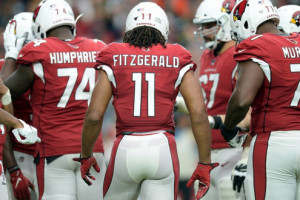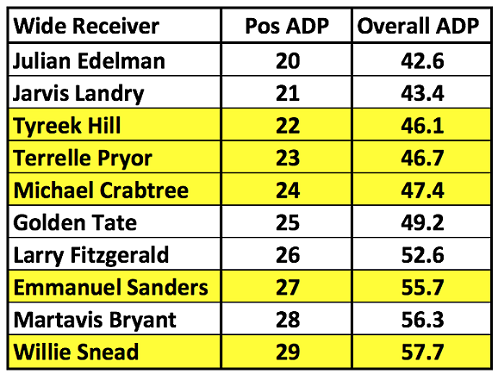Best Ball Strategy: Win Rates and ADP Sweet Spots
![]()
We are taking a break from roster construction this week to talk about one of my favorite statistics: win rate. I mentioned in the first article of this series that I have compiled a database containing the drafts and final results from over 9,000 public best ball leagues. Those drafts span four seasons, from 2013 to 2016. One of the many things this mountain of data has enabled me to do is calculate the “win rate” of every individual player drafted in each of those seasons.
Win rate is a ratio defined by the number of times a player was on a first-place roster divided by the total number of times that player was drafted. The great thing about the win rate statistic is that it distills the combination of player performance and draft cost into a single number. If a player has a very productive year, but you had to spend a first round pick to get him, he was a good pick, but generally not a “league winner,” and in most cases will have an average win rate. However, a player who scores first-round points but costs only a ninth-round pick (e.g. 2015 Devonta Freeman) gives their team a massive advantage, and that is reflected by the player’s high win rate. So what can we learn from win rate data?
Note: The leagues from which I gathered this data were hosted by MyFantasyLeague, which has some differences in rules/settings from Draft, most notably full PPR vs. 0.5 points per reception. That said, I think the conclusions apply across formats.
Editor’s Note: Use promo code “GRINDERS” when you sign up for Draft and get a 100% deposit bonus up to $600 and THREE months of RotoGrinders Draft Premium content!
ADP SWEET SPOTS
Each year is unique, but I have found some patterns in the win rate data that seem to endure season after season. Within each position, there are certain parts of the draft that have offered the right ratio of upside to cost and have been rife with high-win rate picks. These are my Draft ADP Sweet Spots for each position.
Quarterback: QB10 through QB17
Within my four-year sample, 72 percent of quarterbacks with ADPs falling in this range have generated above-average win rates. This sweet spot yielded 16 different quarterbacks who finished top-10 at the position in win rate, versus only 7 who finished outside the top-20. The table below shows the actual players occupying this space in each year. Those with above-average win rates are highlighted in yellow.

The players currently falling within the quarterback ADP Sweet Spot in Draft Best Ball leagues are Marcus Mariota, Kirk Cousins, Derek Carr, Dak Prescott, Matthew Stafford, Philip Rivers, Eli Manning and Andy Dalton. I have been happy to land any of these signal-callers in my drafts, and I often walk away with two.
Running Back: RB35 through RB44
There’s no such thing as a “safe” running back pick, but we can do our best to squeeze as much reward out of the risks we take. The highest running back win rates over the past four years have tended to live at the top of the draft, in the RB1 range, but unfortunately so have the lowest. We saw last year how valuable a healthy bell-cow running back like David Johnson can be (highest win rate at any position, despite a first round ADP), but just one year before it was almost impossible to avoid the carnage among early-round RBs.
As you get later in ADP, you see fewer “busts,” which makes sense. If you miss on your 16th round running back, you’re rarely crippled. But, on the flipside, RB league winners become scarce when we hit the double-digit rounds. There is one later pocket of value, however, that seems to have hit the right balance between upside and cost: RB35-RB44. Here is what that group has looked like the past four years.

I have highlighted the most successful picks from each year. There are plenty of names that did not hit, but because of the low prices, only one player out of 40 had a win rate in the bottom 20% for the position.
What do the winning running backs have in common, besides their ADP? There are some pure “handcuffs” among the winners, but they make up a greater proportion of the misses. For the most part, among the highlighted names, I see running backs thought to be in a committee. That status as a “1b” gave them some stand-alone value (especially in PPR leagues), but also meant there was tremendous room for their role to grow, either through the strength of their own play, or injury to their backfield counterpart. I will target that type of RB in the back half of the draft, with an understanding that most will not pan out. The RBs currently falling in this range on Draft are: Derrick Henry, Latavius Murray, Samaje Perine, Matt Forte, C.J. Prosise, Jamaal Charles, Kareem Hunt, James White, Robert Kelley and Jonathan Stewart.
Perine, Kelley and Latavius make for interesting committee picks, but Forte and Stewart are the names that stand out to me the most. Both seem miscast in this group, given that they don’t even need to “win” bigger roles – they are already the starters. I have been investing pretty heavily in both players while their prices have been depressed. Christian McCaffrey and Bilal Powell are the ones with more work to do to secure big roles, and they are both significantly more expensive than their teammates. Take the discounted touches and touchdowns.
Wide Receiver: WR20 through WR29
Over the past four years, this group of late WR2s-to-early WR3s has been a very good to best ball teams. Compared to all other 40-WR ADP cohorts (10 players times four years), this group has generated the highest average win rate. Even better, it is tied for the second-highest number of above-average win rates and for the second-fewest busts (defined as a sub-10th percentile win rate), while also producing the highest number of 90th-plus percentile players. That combination of safety and league-winning upside at WR just hasn’t existed with such consistency in any other part of the draft.

I can’t explain exactly why this pattern has emerged, but when looking at some of the best picks in that range (e.g. 2013 Pierre Garcon and Antonio Brown, 2014 Roddy White and Julian Edelman, 2015 Jarvis Landry and Brandon Marshall, and last year’s Golden Tate and Larry Fitzgerald), one trend does stand out: VOLUME. These are guys who may not have looked sexy at the time, and in many cases were considered a secondary receiving option on their own team, but they got fed, a lot. Volume not only creates a floor, even in half-PPR leagues, but also means more opportunities for big games.
Here are the WRs currently falling in this sweet spot on Draft. The highlighted players are the ones I have found myself targeting most.

Tight End
There are not as many distinct ADP groups within the tight end position, in large part because there simply aren’t as many tight ends as there are running backs or wide receivers. There also tend not to be many very high win rates at tight end, I suppose because the market has been reasonably good at pricing the position. I will continue to lean on our roster construction principles when deciding in which part of the draft to attack tight end.
There is a pretty well-defined first tier at the moment which includes Rob Gronkowski, Travis Kelce and Jordan Reed. I am happy to take one of those three if they fall beyond their respective ADP’s, but then I am sure to take only one more TE the rest of the way, and I will most likely wait until the mid-to-late rounds to secure my second. I am also happy to skip the first tier and take two from the next group, or wait even longer and collect three from the double-digit rounds. Let the draft dictate when you dip your toes into the TE waters, and let your roster construction dictate when it’s time to get out of the pool.
That will do it for this week. Good luck everyone!